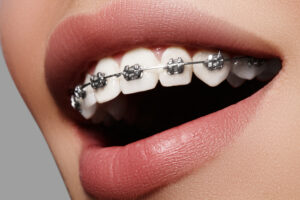How Long Do Braces Take Compared to Other Treatments?
Choosing to straighten your teeth raises a key question: how long do braces take. Some people want fast results. Others prioritize the most effective method, even if it takes longer. With braces, Invisalign, clear aligners, and other systems available, it’s easy to feel unsure. Each option comes with its own timeline, benefits, and limits. Knowing how they compare helps you plan around your goals and schedule.
Average Timeline for Traditional Braces
Traditional metal braces remain one of the most effective solutions for bite correction, crowding, and alignment. They usually take 18 to 36 months to complete the full process. Some people finish faster, while more complex cases may extend the timeline.
Before looking at alternative treatments, it’s important to know what affects how long braces stay on.
Factors That Affect Braces Treatment Time
Several elements can influence the length of your braces treatment:
Severity of the issue
Mild crowding may only take about 12 months. Severe bite or jaw problems can push treatment beyond two years.
Type of braces used
Self-ligating braces may reduce friction, which can shorten treatment time slightly.
Patient cooperation
Wearing elastics, showing up to appointments, and keeping teeth clean help move treatment forward.
Age
Younger patients often respond quicker because their bones and tissues adjust more easily. Once you understand how braces work over time, it helps to compare them with clear aligners like Invisalign.
Ceramic Braces and Lingual Braces
Ceramic braces use tooth-colored brackets. Their function is similar to metal braces, but the materials are more delicate. This can add time if brackets break.
Lingual braces attach to the back of the teeth. These are nearly invisible, but harder to adjust. As a result, treatment may extend slightly beyond the average for traditional braces.
These options appeal to people who want a less noticeable treatment, though they rarely shorten the timeline.
Retainers and Short-Term Alignment Options
Retainers help maintain results. They do not move teeth significantly.
Short-term aligners often target minor adjustments. Some brands promise results in three to six months. These are only effective for small gaps or slightly crooked teeth. They are not suitable for bite problems or significant shifts.
If you’re considering a fast solution, look into newer systems designed to speed up tooth movement.
Fast Braces and Accelerated Orthodontics
Some treatments claim to reduce orthodontic time through added technology or unique designs. These include:
-
Fastbraces
-
Propel
-
AcceleDent
These systems often promise results within six to twelve months. They use additional methods like vibration or micro-impulses to stimulate movement. However, they don’t work for every case and often involve higher costs.
Are Faster Treatments Worth It?
Quick treatments sound attractive, but they may involve trade-offs. Some patients risk relapse if teeth shift too quickly and the roots don’t stabilize. Pressure on teeth may also cause discomfort or sensitivity. Long-term stability should be the goal.
To help you understand the differences clearly, here’s a comparison of the main treatment options and their average timelines.
Comparison of Average Treatment Times
| Treatment Type | Average Duration | Best For |
|---|---|---|
| Metal Braces | 18 to 36 months | Moderate to complex cases |
| Ceramic Braces | 18 to 36 months | Aesthetic preference |
| Lingual Braces | 18 to 36+ months | Hidden appliances |
| Invisalign | 12 to 18 months | Mild to moderate issues |
| Fastbraces / Accelerated | 6 to 12 months | Simple or cosmetic fixes |
| Short-Term Aligners | 3 to 6 months | Minor changes only |
Now that you’ve seen how long treatments take, it helps to understand what the entire orthodontic process looks like from start to finish.
Phases of Treatment
Consultation and Diagnostic Assessments
Your first visit includes a review of your dental history, digital scans, and photos. The orthodontist checks your bite and tooth alignment.
Treatment Planning
Your provider explains which treatment is suitable for you. This step includes reviewing estimated time and cost.
Brace Fitting or Aligner Start
Braces are bonded to your teeth in one session. If you’re using clear aligners, you’ll receive the first few trays and instructions.
Adjustment Period
You may feel tightness or soreness during the first week. This means the appliance is beginning to work.
Regular Follow-Ups
Braces patients visit every 4 to 6 weeks. Invisalign patients return every 6 to 8 weeks. These visits allow adjustments and check for progress.
Retention Phase
After active treatment ends, you receive retainers. They keep teeth in place while the bones and gums adjust. Skipping retainers can cause teeth to shift again.
Tips to Stay on Track with Treatment Time
Every treatment works better when patients stay consistent. Here’s how you can avoid delays:
-
Show up to all scheduled visits
-
Keep your teeth and appliance clean
-
Follow instructions about elastics or aligners
-
Report any damage or pain early
-
Wear your retainers as prescribed
What to Expect During Your First Appointment
Your first visit at Dr. Lints Orthodontics includes a full assessment. The team will check your teeth, take records, and explain which treatment options work best for your case. You’ll also learn how long your treatment may take and what to expect in terms of appointments, cost, and follow-up.
We welcome patients from Traverse City, Elk Rapids, and Suttons Bay.
Why Choose Dr. Lints Orthodontics?
Dr. Lints has served Northern Michigan for over 30 years. He is a board-certified orthodontist and Diamond Invisalign Provider. The practice uses advanced technology to plan treatments and improve comfort. Consultations are free. All treatment plans are based on your personal needs and goals.
Ready to Straighten Your Smile?
Call Dr. Lints Orthodontics or book online to schedule your free consultation. We serve patients across Traverse City, Elk Rapids, and Suttons Bay.
FAQs
What foods should I avoid while wearing braces?
Avoid sticky, crunchy, or hard foods. These include gum, caramel, popcorn, and ice. Choose softer items like pasta, rice, or yogurt to avoid breaking brackets.
Can I switch from braces to Invisalign mid-treatment?
Sometimes. If your case is suitable and progress is good, your orthodontist may allow a switch. Not all patients qualify, and this may affect cost and results.
Do braces cause long-term changes in facial structure?
Braces can improve symmetry. This is more common in younger patients whose jaws are still growing. Changes are typically positive and subtle.
How often do I need to visit the orthodontist during treatment?
Most patients with braces go every 4 to 6 weeks. Invisalign patients usually return every 6 to 8 weeks for new aligners and progress checks.
Are there any risks or side effects with accelerated orthodontic methods?
These systems can cause temporary soreness or gum sensitivity. They are not right for everyone. Speak with your orthodontist to find out if they are safe and effective for your case.
GETTING STARTED WITH INVISALIGN
If Invisalign sounds like it is the right fit for you, call or text us to set up a complimentary consultation. During this consultation, Dr. Lints and team will:
- 1. Review your dental and medical history
- 2. Perform a complete oral exam
- 3. Help you determine if Invisalign is the best route for you
- 4. Create you a customized treatment plan with before and after simulation
- 5. Discuss flexible payment plan options and insurance benefits if applicable



